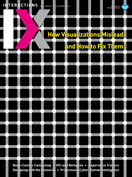Authors:
Simone Barbosa, Gilbert Cockton
As we are increasingly consuming and producing information in visual form, it's important that visualizations communicate data accurately. Danielle Szafir's cover story alerts us to how poor visualization design decisions may mislead us and discusses how to avoid some of those pitfalls. Taking a broader perspective on design, Will Odom shares book recommendations that expand our view beyond just designing technologies to designing a wide range of experiences. Uday Gajendar makes the case for design artifacts by highlighting their revealing nature in supporting reflection and debate. In a piece that first ran on our blog, Mattias Arvola reproduces an interesting conversation about interactive form and the many meanings the concept entails. From design to adoption and use, Michael Twidale proposes to engage people with current or future user experiences through experience trailers—think movie trailers. From the digital to the material, Mikael Wiberg uses an architectural lens to prompt us to imagine superstructures for interaction. Bridging the digital and physical worlds, Andrew J. Hunsucker, Emily Baumgartner, and Kelly McClinton ask us to advance the research on designing for augmented reality.
The role of HCI in improving our well-being is a recurrent theme in this issue.
The role of HCI in improving our well-being is a recurrent theme in this issue, from Florian "Floyd" Mueller's account of a Dagstuhl seminar on body-centric computing, through Gitte Lindgaard's Abracadabra column on exergames for long-term rehabilitation and pain management, to Thanassis Rikakis and colleagues' proposal to use artificial intelligence to improve the overall human condition. Dorian Peters and Rafael Calvo give an account of the research goals and activities conducted at the Wellbeing Technology Lab in Sydney.
Gilberto Esparza describes how his BioSoNot system integrates living beings and technology to heighten the visibility of environmental pollution. Making the invisible visible is also a goal of the Wind Ceremony demo, while Pepper's Cone conjures 3D from 2D through clever design. Project Telepathy enhances private communication abilities by enabling people to communicate through subtle facial movements. Subtlety is also a characteristic of Ian Gonsher's Tablebot (Tbo) robot, which doubles as furniture.
Not all technology needs to have a functional purpose. Artistic effects can be achieved in any number of ways, even by integrating bacteria and other living beings into our design, as in Stacey Kuznetsov's bioart and Tyler Fox's use of bioluminescent algae. It can also arise unintentionally, and even due to technology glitches, as illustrated by the Digital Auras in EXIT.
Different communities, different needs. Reem Talhouk and colleagues share their experience in doing HCI research in the context of refugee crises, while Community Square looks back over 10 years of the Greece ACM SIGCHI Chapter, GrCHI, and its activities influenced by the country's rich archeological and cultural heritage. Naja L. Holten Møller discusses how feminist HCI may inform how we deal with shifts in clerical work that may be displaced by artificial intelligence and automation, calling upon us to design socially responsible technology. Finally, Gusa Armagno scrutinizes the complexity of developing non-traditional user interfaces for children with physical disabilities.
Simone Barbosa and Gilbert Cockton [email protected]
Copyright held by authors
The Digital Library is published by the Association for Computing Machinery. Copyright © 2018 ACM, Inc.








Post Comment
No Comments Found